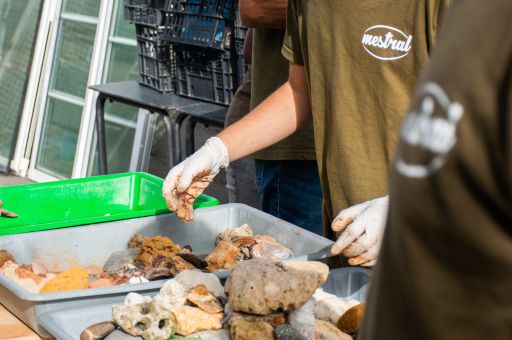The collection of 987.55 kg of stones, sand and fossils in 2024 reflects a slight decrease compared to the previous year, consolidating the efforts to preserve Menorca’s geological heritage.
The Department of Environment, Biosphere Reserve and Cooperation of the Island Council of Menorca, in collaboration with Mestral, has once again carried out the campaign of classification and return of geological material confiscated from travellers at the airport of Menorca. This year, 987.55 kg of stones, sands and fossils have been collected and will be returned to their geological areas of origin, a slightly lower amount than last year, when 1,038 kg were recovered.
TDB keeps you informed. Follow us on Facebook, Twitter and Instagram
Nearly one tonne of geological material seized at Menorca airport returns to its natural habitat
Every year, many visitors and residents take stones, sand and fossils from Menorca’s beaches, a practice that may seem harmless but has a significant impact on the island’s geological heritage. Thanks to the collaboration between the Island Council of Menorca, the airport and Mestral, a part of this seized material is recovered and returned to its natural environment.
David Vidal, island director of the Biosphere Reserve, stresses the need to preserve this heritage. ‘Menorca’s geological elements play a key role in the ecosystem of our beaches. We must learn to respect the environment to ensure that Menorca remains intact for future generations.
The importance of geological formation
This task is carried out through Mestral’s work insertion programme, where the participants of the programme are in charge of classifying the requisitioned elements after having received specialised training on Menorca’s geology.
Menorca is divided into two main geological regions: the Tramontana region, also known as Migjorn and the southern region. In the northern part, you can find Menorca Fosca, Menorca Roja and Menorca Grisa, while in the south Menorca Blanca predominates, which is the most extensive. There are also small geological areas distributed all over the island known as Menorca Groga. This colour classification, proposed by the Geology Centre of Menorca, is an educational tool to facilitate the identification of the different geological areas of the island and to ensure that the requisitioned material is returned to its correct area.
Agustí Rodríguez, geologist and director of the Geology Centre of Menorca, explains that ‘we take advantage of this process to highlight the geology of Menorca. In addition to identifying the different geological materials, we explain the importance of preserving this unique natural heritage. The training we provide helps to raise awareness of the geological value of the island, which has taken millions of years to form.
After sorting, the material will be returned to the corresponding geological units, as has been done in previous years. The Consell Insular’s Beach Cleaning Service will be in charge of distributing the recovered material to various beaches and areas of the island.
A project underway since 2015
Since 2015, the project has made it possible to recover and return tonnes of geological material seized at Menorca airport. In 2024, 987.55 kg of stones and sands have been collected, a further contribution to the protection of the island’s natural environment. However, it is very difficult to calculate the total amount of material removed, as many visitors and also residents of Menorca take stones or sand with them by boat or in their checked luggage.
2015: 2086 kg
2016: 1160 kg
2017: 1715 kg
2018: 1683 kg
2019: 1479 kg
2020: 1162 kg
2021: 3904 kg
2022: 867 kg
2023: 1038 kg
2024: 987 kg
